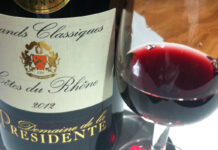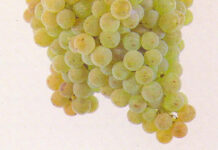Luke Richardson is the sommelier at wine bar Le Di-Vin in Edinburgh. In his column for SLTN he shares his thoughts on all things wine-related and answers your questions about wine. If you have a question for Luke email it to sltn@peeblesmedia.com

HI again all, and Happy New Year!
I thought this month I would take a look at Cabernet Sauvignon – for many the king of all red grape varieties.
It is planted in pretty much every wine growing country in the world and produces wines at all price points from around £5 + VAT and upwards.
Originally it was probably the result of an accidental crossing of Sauvignon Blanc and Cabernet Franc in Bordeaux in the 17th century, and Bordeaux remains its spiritual home – although a relatively expensive place to start.
The entry levels tend to be New World – Australian, Chilean or South African mostly, and offer ripe, attractive fruit, big but fine tannins, and a plethora of flavours related to where it is grown. Most often there is a core of blackcurrant, a bit of minerality, and touches of eucalyptus or aromatic leaves on the finish.
Good, accessible flavours for the money at £4.50 to £5 + VAT up to about £8 to £8.50 for the better examples.
Coonawarra in Australia, Colchagua in Chile and Stellenbosch in South Africa are go-to regions, and are amongst my favourites – although Franschoek is also producing high quality, slightly more savoury flavoured Cab Sauv in this price range. There are also wines from Bordeaux in this price range, but few of them offer the accessibility or the generous nature of the New World examples and I would definitely advocate spending more like £8 to £12 per bottle for something half decent – look for wines from Haut Medoc or Entre Deux Mers. Still simple by Bordeaux standards, but also more accessible at a younger age – think about the pretty good 2016 vintage or the excellent 2015.
Staying in France, you also often get vin du pays in the Languedoc solely made from Cabernet Sauvignon, and they can be a bit more generous on the fruit, and often slightly herbal on the finish. Think blackcurrant, hints of black cherry, bay leaf and fine tannins with a smack of acidity in the tail; £6 + VAT for something fairly simple, £9 for something decent – need about two years from vintage to start rounding out on the fruit.
Going back to the New World regions I mentioned earlier and the wines at £8 to £12 are markedly more classy than their cheaper cousins – more reserved, less jammy fruit, more poise, balance and length – and also show more regional typicity.
Coonawarra shows ripe, rich chocolatey fruit with a distinct Eucalyptus or menthol note on the finish; South African examples show more leather and spice in the tail, with a core of dark blackcurrant; and the good Chilean examples show touches of leather/tobacco spice pulling back the ripe Cassis, Griottine cherry fruit.
For the biggest examples, look to California, and specifically Napa Valley, although the entry point is at the £11 or £12 + VAT level and up, so not cheap. These wines are the richest, ripest examples, often with a cedar-like finish and dark brooding fruit with overtones of vanilla and cigar spice and a long finish.
So, a real all-rounder and, essentially, you get what you pay for – if you want the leaner style, stick to the Old World, and if you’re after the riper fruit, then look further afield.
Happy hunting!
























